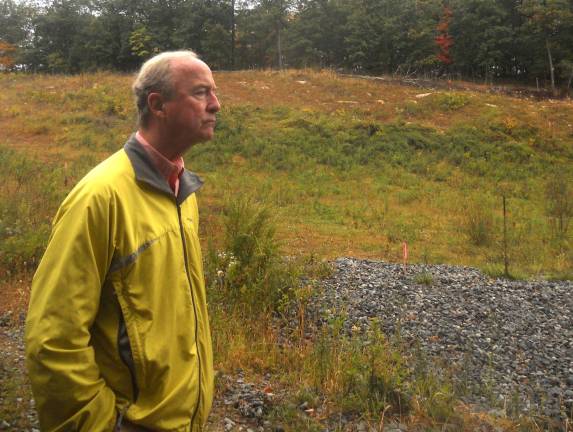Congressman visits toxic dump site

By Amy Stewart
BYRAM — “Polluters Pay” was the mantra of Congressman Rodney Frelinghuysen on Monday morning as he hiked the Mansfield Trail in the fog and drizzle.
A section of the trail is a toxic dumpsite that is considered a Superfund site because of the level of contamination and its proximity to residential homes.
It was listed in the NPL (National Priorites List) for cleanup in 2011. A site that is listed as a Superfund Site and on the NPL is eligible for federal funding for the cleanup.
The contaminated site was discovered in 2006 when a local resident did a routine well test. The results revealed high levels of TCE, a chemical compound used as a commercial degreaser with known health risks.
Once a year, Frelinghuysen tours all of the NPL sites in his district because he said, “It is important to measure the progress of the work being done. Cleanups are expensive so it is important to get them cleaned up quickly and efficiently.”
The Congressman explained that New Jersey has 135 Superfund Fund sites, the highest percentage in the country, nine of which are in his district. “It is important that we find the polluters and that they pay for the cleanup. On 70 percent of the sites the polluters have been found and are paying. Only 30 percent do not have identified polluters. This site is one of the 30 percent. It is a quality of life issue and I support the Superfund program.”
The Congressman complemented and thanked Kristin Giacalone, Remedial Project Manager, and all others who have worked on the project, worked cooperatively with local officials and keeping the public involved through the Community Advisory Group (CAG) run by Pat Seppi, Community Involvement Coordinator for the EPA.
Frelinghuysen added, “[There's] a direct correlation between progress at sites and congressional visits.” He expressed his hopes that more elected officials do similar tours.
Frelinghuysen admitted that is unfortunate that a responsible party cannot pay for the Mansfield Trail cleanup.
The owner of the property died well over 10 years ago. The property is still held in the estate and no business records have been found, leading to a dead end in recovering any of the $1.8 million already spent. “The responsibility parties should be paying for any and all cleanups, not the American taxpayer,” said Frelinghuysen.
Regarding the work currently happening on the site, Giacalone explained that wells would continue to be drilled, geo-probing will go on and tests for water and soil contamination will be done at the mobile lab that is on site.
When asked by the Congressman when the situation should be complete, Giacalone explained it will take about three years to complete the feasibility study and after approximately five years a Record of Decision should be received which will lay out the final actions needed to be taken to consider the matter done.
The future of the site and the surrounding homes is of great concern to homeowners who have been affected by the TCE.
Point of Entry Treatment Systems (POETS) and ventilation systems have been installed rendering the homes safe for habitability and with no negative health consequences from the TCE. Homeowners are concerned about their futures however.
Currently the state is paying for the cost of the POETS. When a home changes hands the cost then gets passed on to the new owner. Bill S576 was introduced to State legislators to keep the cost of maintaining the POETS in the hands of the state. The bill passed and was forwarded to the Governor to sign, but he vetoed it. When asked by resident, Donna Griff, if the Congressman had any advice he said, “The bill needs to be reintroduced in both houses. We will work on the Governor to take another look at it. It seems reasonable that the coverage should continue.”
Before he left, Frelinghuysen said he was committed to getting the job done and vowed “We will drive you crazy. I’ll be here when you want me and even when you don’t want me.”